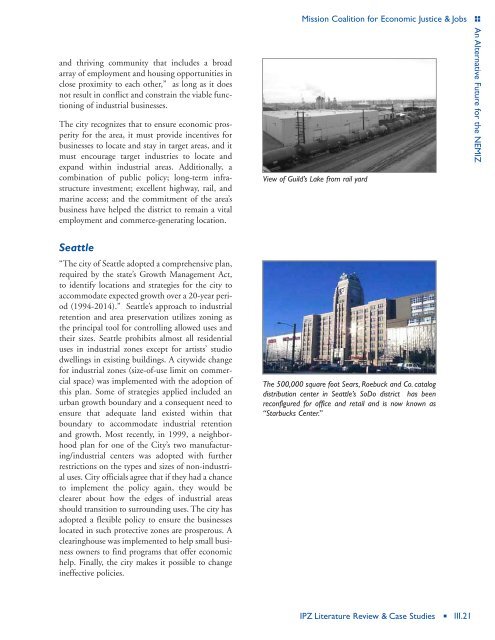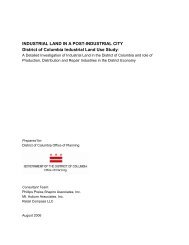An Alternative Future for the North East Mission Industrial Zone
An Alternative Future for the North East Mission Industrial Zone
An Alternative Future for the North East Mission Industrial Zone
You also want an ePaper? Increase the reach of your titles
YUMPU automatically turns print PDFs into web optimized ePapers that Google loves.
and thriving community that includes a broad<br />
array of employment and housing opportunities in<br />
close proximity to each o<strong>the</strong>r,” as long as it does<br />
not result in conflict and constrain <strong>the</strong> viable functioning<br />
of industrial businesses.<br />
The city recognizes that to ensure economic prosperity<br />
<strong>for</strong> <strong>the</strong> area, it must provide incentives <strong>for</strong><br />
businesses to locate and stay in target areas, and it<br />
must encourage target industries to locate and<br />
expand within industrial areas. Additionally, a<br />
combination of public policy; long-term infrastructure<br />
investment; excellent highway, rail, and<br />
marine access; and <strong>the</strong> commitment of <strong>the</strong> area’s<br />
business have helped <strong>the</strong> district to remain a vital<br />
employment and commerce-generating location.<br />
Seattle<br />
“The city of Seattle adopted a comprehensive plan,<br />
required by <strong>the</strong> state’s Growth Management Act,<br />
to identify locations and strategies <strong>for</strong> <strong>the</strong> city to<br />
accommodate expected growth over a 20-year period<br />
(1994-2014).” Seattle’s approach to industrial<br />
retention and area preservation utilizes zoning as<br />
<strong>the</strong> principal tool <strong>for</strong> controlling allowed uses and<br />
<strong>the</strong>ir sizes. Seattle prohibits almost all residential<br />
uses in industrial zones except <strong>for</strong> artists’ studio<br />
dwellings in existing buildings. A citywide change<br />
<strong>for</strong> industrial zones (size-of-use limit on commercial<br />
space) was implemented with <strong>the</strong> adoption of<br />
this plan. Some of strategies applied included an<br />
urban growth boundary and a consequent need to<br />
ensure that adequate land existed within that<br />
boundary to accommodate industrial retention<br />
and growth. Most recently, in 1999, a neighborhood<br />
plan <strong>for</strong> one of <strong>the</strong> City’s two manufacturing/industrial<br />
centers was adopted with fur<strong>the</strong>r<br />
restrictions on <strong>the</strong> types and sizes of non-industrial<br />
uses. City officials agree that if <strong>the</strong>y had a chance<br />
to implement <strong>the</strong> policy again, <strong>the</strong>y would be<br />
clearer about how <strong>the</strong> edges of industrial areas<br />
should transition to surrounding uses. The city has<br />
adopted a flexible policy to ensure <strong>the</strong> businesses<br />
located in such protective zones are prosperous. A<br />
clearinghouse was implemented to help small business<br />
owners to find programs that offer economic<br />
help. Finally, <strong>the</strong> city makes it possible to change<br />
ineffective policies.<br />
<strong>Mission</strong> Coalition <strong>for</strong> Economic Justice & Jobs<br />
View of Guild’s Lake from rail yard<br />
The 500,000 square foot Sears, Roebuck and Co. catalog<br />
distribution center in Seattle’s SoDo district has been<br />
reconfigured <strong>for</strong> office and retail and is now known as<br />
“Starbucks Center.”<br />
IPZ Literature Review & Case Studies <br />
III.21<br />
<strong>An</strong> <strong>Alternative</strong> <strong>Future</strong> <strong>for</strong> <strong>the</strong> NEMIZ












